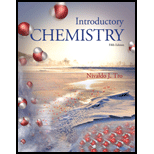
Introductory Chemistry Plus MasteringChemistry with eText - Access Card Package (5th Edition) (New Chemistry Titles from Niva Tro)
5th Edition
ISBN: 9780321910073
Author: Nivaldo J. Tro
Publisher: PEARSON
expand_more
expand_more
format_list_bulleted
Question
Chapter 1, Problem 3E
Interpretation Introduction
Interpretation:
The blanks in the given statement are to be filled.
Concept introduction:
The chemist is interested in the connection between properties of substance and structure of particles.
The chemist is interested in why the ordinary substance is in the way they are.
Expert Solution & Answer
Want to see the full answer?
Check out a sample textbook solution
Students have asked these similar questions
H-
H
H
H
H
H
H
Identify and select all structures below that represent a constitutional isomer(s) of the compound shown above.
H-
H
H
H
A.
H
H
H
H-C
CI
H
H
D.
H
H
H
H
H
H
C
C
-H
H
C
C
H
H
H
H
B.
H
CI
H
H-
C
C
H
H
H
H
E.
H
CI
H
C.
Why doesn't this carry on to form a ring by deprotonating the alpha carbon and the negatively-charged carbon attacking the C=O?
6. A solution (0.0004 M) of Fe(S2CNEt2)3 (see the structural drawing below) in chloroform
has absorption bands at:
350 nm (absorbance A = 2.34);
514 nm(absorbance A = 0.0532);
Calculate the molar absorptivity values for these bands. Comment
on their possible nature (charge transfer transitions or d-d
S
N-
transitions?).
(4 points)
Chapter 1 Solutions
Introductory Chemistry Plus MasteringChemistry with eText - Access Card Package (5th Edition) (New Chemistry Titles from Niva Tro)
Ch. 1 - Where can you find chemicals? a. In a hardware...Ch. 1 - Q2. Which statement best defines chemistry?
a. The...Ch. 1 - According to the scientific method, what is a law?...Ch. 1 - Q4. Which statement is an example of an...Ch. 1 - Which characteristic is necessary for success in...Ch. 1 - Why does soda fizz?Ch. 1 - 2. What are chemicals? Give some examples.
Ch. 1 - Prob. 3ECh. 1 - 4. What is meant by the statement, “Matter does...Ch. 1 - Define chemistry.
Ch. 1 - 6. Many things that we take for granted in...Ch. 1 - 7. Explain the scientific method.
Ch. 1 - 8. What is wrong with the statement, “The...Ch. 1 - What is the difference between a law and a theory?Ch. 1 - 10. What is the difference between a hypothesis...Ch. 1 - What is wrong with the statement, It is just a...Ch. 1 - What is the law of conservation of mass, and who...Ch. 1 - What is the atomic theory, and who formulated it?Ch. 1 - A chemical experiment might look for one or more...Ch. 1 - Examine the opening figure of this chapter. Use...Ch. 1 - Examine Figure 1.1 and, from a molecular point of...Ch. 1 - Prob. 17ECh. 1 - 16. Classify each statement as an observation, a...Ch. 1 - 17. A student prepares several samples of the same...Ch. 1 - A student measures the volume of a gas sample at...Ch. 1 - A chemist in an imaginary universe does an...Ch. 1 - 20. A chemist decomposes several samples of water...Ch. 1 - 21. The manufacturer of a particular brand of...Ch. 1 - Prob. 24ECh. 1 - 23. In your own words, provide a brief definition...Ch. 1 - 24. How curious are you? How good are your...
Knowledge Booster
Similar questions
- What is the mechanism for this?arrow_forwardFor questions 1-4, consider the following complexes: [Co(CN)6], [COC14]², [Cr(H2O)6]²+ 4. Room temperature (20°C) measurement of molar magnetic susceptibility (Xm) for Fe(NH4)2(SO4)2×6H2O is 1.1888 x 102 cgs (Gaussian units). Calculate effective magnetic moment and provide a number of unpaired electrons for the iron ion. Use this number to rationalize the coordination geometry around iron center. (4 points)arrow_forward7. Describe the expected 31P and 19F (where applicable) NMR spectral patterns for the following compounds (indicate number of signals and their splitting patterns). a) tetraphenyldiphosphine Ph Ph P-P Ph Ph Ph Ph ' b) tetraphenyldiphosphine monoxide P-P-Ph Ph (2 points) (2 points c) tetrafluorophosphonium hexafluorophosphate [PF4]*[PF6]¯ (4 points)arrow_forward
- 3. For questions 1-4, consider the following complexes: [Co(CN)6]4, [COC14]², [Cr(H2O)6]²+ Which (if any) of these complexes would be expected to display Jahn-Teller distortion? (2 points)arrow_forwardWhat is Instrumental Neutron Activation and what are the advantages and disadvantages in using its applications? (I'm doing an in class assignment and need better understanding of what the instrument can be used for) Please include references so that I can better understand the application of how the instrument works!arrow_forwardWhat is Isotope Analysis and what are the advantages and disadvantages in using its applications and instrumentalization? Please include references so that I can better understand how the instrument works!arrow_forward
- 5. Count the electrons on the following complexes and state whether they follow the 18- electron rule: (3 points) Fe(CO)5 Ni(PMe3)4 PMe3 is trimethylphosphine Mn(CO)5Brarrow_forwardFor questions 1-4, consider the following complexes: [Co(CN)6]+, [CoCl4]², [Cr(H2O)6]²+ 2. Draw the corresponding d-orbital splitting for each of the complexes; predict the spin- state (low-spin/high spin) for each of the complexes (if applicable); explain your arguments. Calculate the crystal field stabilization energy for each complex (in Ao or At). (6 points)arrow_forwardFor questions 1-4, consider the following complexes: [Co(CN)6]4, [COC14]², [Cr(H2O)6]²+ 1. Assign oxidation number to the metal, then indicate d-electron count. (3 points)arrow_forward
- Using iodometry I want to titrate a sodium thiosulfate solution and I use 15 mL. If I have 50 mL of a 0.90 M copper solution and KI, what will be the molarity of sodium thiosulfate?arrow_forwardDraw the product formed when the following pair of compounds is treated with NaOEt in ethanol. + i CNarrow_forwardI need help with the followingarrow_forward
arrow_back_ios
SEE MORE QUESTIONS
arrow_forward_ios
Recommended textbooks for you
- Chemistry: Matter and ChangeChemistryISBN:9780078746376Author:Dinah Zike, Laurel Dingrando, Nicholas Hainen, Cheryl WistromPublisher:Glencoe/McGraw-Hill School Pub Co

Chemistry: Matter and Change
Chemistry
ISBN:9780078746376
Author:Dinah Zike, Laurel Dingrando, Nicholas Hainen, Cheryl Wistrom
Publisher:Glencoe/McGraw-Hill School Pub Co